W. Candra Dwipa P. , S. Komariyah , Hr Cahyo Diartho
Program Master in Economics-Post Graduate Program, Faculty of Economics and Business, University of Jember, Jember, Indonesia
Correspondence to: Hr Cahyo Diartho , Program Master in Economics-Post Graduate Program, Faculty of Economics and Business, University of Jember, Jember, Indonesia.
| Email: |  |
Copyright © 2020 The Author(s). Published by Scientific & Academic Publishing.
This work is licensed under the Creative Commons Attribution International License (CC BY).
http://creativecommons.org/licenses/by/4.0/

Abstract
This research aims to analyze sustainable development Dasawarsas BUMDesa that in terms of the economic, social, and political, legal and institutional dimension and the dimension of the infrastructure. Sustainability is very important because it is expected to become an independent business entity and also as an example for other BUMDesa management. Sustainability BUMDesa Dasawarsa in Pamekasan as multidimensional has an index value of sustainability status are included in the category of sustainable enough, meaning that the index value of all dimensions include: the economic, social, legal and institutional, infrastructure and technology has an influence on the sustainability BUMDesa Dasawarsa. The most influential dimension to sustiaine BUMDesa Dasawarsa namely the economic dimension, when compared with the other dimensions (social, legal and institutional, infrastructure and technology). The economic dimension has a value of the highest sustainability index and have a great chance to increase the sustainability status of BUMDesa Dasawarsa. In the future it’s necessary to repairs sensitive or attributes that affect the sustainability status BUMDesa Dasawarsa and improvement of the attributes that are not sensitive for their status to be improved sustainability sensitive attributes. Improvements to the dimensions of sustainability attributes that have a value lower sustainability index to be prioritized, such as legal and institutional dimensions and infrastructure and technology. Meanwhile, economic and social dimensions of sustainability forward index value can be maintained or further improved.
Keywords:
Sustainability BUMDesa, Multidimensional Index (MDS)
Cite this paper: W. Candra Dwipa P. , S. Komariyah , Hr Cahyo Diartho , Sustainability of Village Business Agencies (BUMDesa) and Development Strategy in Pamekasan District, American Journal of Economics, Vol. 10 No. 1, 2020, pp. 11-20. doi: 10.5923/j.economics.20201001.03.
1. Introduction
Development of rural economic base which has been run by the current government has not been optimal level of success achieved. One of the most dominant factor is government intervention is too large, resulting in hampering the creativity and innovation of rural communities in managing and running the economic engine in rural areas. System and institutional mechanisms in the rural economy has not been effective and has implications for dependence on government assistance so deadly spirit of independence.One effort that can be done is to encourage rural economic movement through rural entrepreneurship, where entrepreneurship village into a strategy in the development and growth of welfare (Bahareh Ansari, 2013). Entrepreneurship can be accommodated in the village of village-owned enterprises (BUMDesa) developed by the government and the villagers (Prabowo, 2014). BUMDesa is a business entity of all or most of its capital owned by the village through direct investments originating from the wealth of the village were separated in order to manage the assets, services, and other measures for the welfare of the villagers (Act No. 32 of 2004). It is increasingly supported by the government of PP No. 47 of 2015 which states that the village has an authority to manage the resources and direction of development.The government policy through rural development contained in Law No. 6 of 2014 on institutional economics Village indicate there’s institutional economics that want to build by the goverment in rural areas. Rural region is an area that has a major agricultural activities, including the management of natural resources with the composition functions as a rural residential area, government services, social services and economic activities.Law No. 6 of 2014 and its regulations have mandated the implementation of village government to be more independent in managing government and various natural resources that are owned, including financial management and wealth belongs to the village. Law No. 6 of 2014 on Village gives new impetus so village can be more developed, which means that the village is placed as the first milestone of the success of national development. Thus strengthening the village is not separated from the village force in extracting the potential of local wisdom and spirit of mutual cooperation of its citizens.Community empowerment and facilitation of the government to manage the economic potential for the welfare of the population and rural development, until now not scheduled as a priority by the local government. Whereas Law Number 32 of 2004 Section 213 of the village-owned enterprises (BUMDesa) and Article 214 on cooperation between villages, can serve as the basis / capital in an effort to empower rural communities. Community empowerment as a process of enabling and society's independence, generally intended to increase welfare. The process of empowerment and automation in this case not in the form of facilitation given to the village communities to manage the economic potential in their villages (Kartasasmita, 1997).Village-owned enterprises (BUMDesa) is an instrument of local economic empowerment with various types of businesses in accordance with the potential of the village. The development of this potential has a goal to improve the economic welfare of the villagers through the development of economic enterprises. In addition, the presence of BUMDesa also had an impact on the increase in rural-source revenue (PAD), which allows the village to be able to do a development and also to improve the welfare of more optimally. BUMDesa true as social institutions that favor the interests of the community through its contribution as a provider of social services. However BUMDesa as well as commercial establishments where BUMDesa aims to make a profit through the sale of goods or services that are intended to society (Adawiyah, 2018).Management of village-owned enterprises (BUMDesa) should pay attention to the values embraced by the local community around so that business activities can synergize with the community. In addition to the values embraced by people around the most important thing that is required by the village-owned enterprises (BUMDesa) is a venture capital fund or in conducting its business Operations. Venture capital received BUMDesa able to create a trickle down effect, which means that venture capital can support all forms of productive activities that have been planned BUMDesa so as to increase household income and Revenue Villages (Andrian Dolfriandra Huruta, 2016).Pamekasan is one of the districts whose territory is located in the province of East Java. Pamekasan regency in implementing development wilayanya also developed the concept of development in the rural area through community empowerment through village-owned enterprises (BUMDesa) that its development is based on its potential to boost the economy, especially in rural communities. Village-owned enterprises (BUMDesa) which had been formed some 50 BUMDesa one of which is located in the Dasawarsa BUMDesa Waru West. Waru West has an advantage compared to other villages in the region in Pamekasan regency,The obstacles can be the cause of less optimal management and utilization of the Dasawarsa BUMDesa efforts for rural communities in Waru West, based on the explanation above. This study aims to explain how sustainable development Dasawarsas BUMDesa that in terms of the economic, social, and political and formulate strategies needed to develop into enterprises yng independently and also as an example for the management of BUMDesa in other villages especially in Pamekasan.
2. Literature Review
2.1. Reinventing Government Theory
The changing concept of public bureaucracy basically been a long time since the 1980s introduced by theorists such as Hood and Pollitt, as criticism of the old bureaucratic performance (Weberian models) that have been unable to meet public expectations in line with the changing strategic environment. As said by David Osborne and Ted Gaebler that: The form of government that developed during the industrial era, with a slow and centralized bureaucracy, compliance with rules and regulations as well as the hierarchical chain of command, no longer run properly. They (the government bureaucracy) becomes swollen, wasteful and ineffective. And when the world began to change, they failed to adjust to the change. Bureaucracy centralized and hierarchical design results in the 1930s or 1940s did not function well in society and the economy of the 1990s that is rapidly changing, information-rich and solid knowledge. They are like a luxury liner in the age of supersonic aircraft large, cumbersome, costly, and very difficult to spin. Gradually was replaced by other forms of new public institutions (Osborne, 2005).Reinventing Governmentis a thought and movement to develop a government that has a soul and entrepreneurial spirit. An important feature of the entrepreneurial government of which has the ability to use existing resourses in an efficient, innovative and responsive to community needs. The government will only be able to develop an entrepreneurial spirit if throw away the bad nature of officials and which has straddled. Characteristics of a centralized government bureaucracy, hierarchical, monopolistic, reactive and formalistic flow is replaced by a decentralized, organic adaptive, competitive, anticipatory and participatory (Dwiyanto 1996). Osborne (2005) suggests ten ways to form a bureaucratic-entrepreneurial, namely:1. Government policy makers must be more of a director than to be executor. For example is the collaboration with the private sector in tax purposes, but the determination of the taxpayer and the tax levy fixed by the government.2. Government as belonging to the community should empower the continuous rather than serving the public. One of the efforts is to urge the public to be able to take care of the security of their own environment.3. Government as an institution is in the nature of competition should inject the spirit of competition into the body of the apparatus and the service organization. For example, by providing opportunities for the private sector in the affairs that monopolized the government, such as drinking water, electricity, and telephone.4. The units of government as an institution in charge of realizing the mission should be given the freedom to create and innovate. To that end, the guidelines are rigid and binding must be avoided, both regarding finance, personnel, and services to the community.5. The government should be more concerned with results to be achieved rather than overly focusing on input factors (input). For example, the provision of assistance to a school should be based on performance and productivity than the number of students.6. The Government as a public servant should be more concerned with the fulfillment of customer satisfaction, instead of fulfilling what is the willingness of the bureaucracy itself. To that end, new ways to lure customers to do.7. The Government as a business entity must be good at making money and not only can spend. Therefore, ways to seek new income sources and encouraging investment should always be thinking of the managers of government.8. The Government as an institution that has an anticipatory power must be able to prevent rather than just tackling the problem. For example about the fire, using this principle and not a fire engine that was purchased on but supervision / monitoring of the buildings must be improved.9. The government should shift working pattern hierarchy espoused to a working model of participation and cooperation. For example, a long chain organization and 'fat' should be reduced, the organizational structure should be thinned thickness, and quality control should be developed.10. The Government as a market-oriented parties should strive mengatrol changes through its control of the market mechanism. For example, in dealing with waste from beverage bottles, rather than financing an expensive recycling efforts, better government requires employers to pay any buyer drink that restores the bottle.Building Entrepreneurship spirit in bureaucratic effort will have an impact on changes (reforms) in the local government entities. Changes made is in order to make adjustments to the bureaucratic mechanisms of entrepreneurship in each layer of bureaucracy. Such changes can be de-bureaucratization, deregulation, local government reconstruction, repositioning instansiinstansi, even employee rationalization. In the process, the adjustment efforts should be ensuring the creation of local government productivity and work efficiency are maximized. Expand substantially, attempts mewirausahakan Local Government bureaucracy, as well as to achieve self-government, as well as to support the changing role of government in society facing rapid development in the era of Globalization (Zulkarnaini, 2013).
2.2. Socio Entrepreneurship Theory
JG Dees as person with his social entrepreneurship, social entrepreneurship spirit, the spirit of giving value to society by applying entrepreneurial principles. Social Entrepreneurship is basically limited to a social action of an institution, organization or company through CSR, Corporate Social Responsibility or other social institutions (Dees, 1998).Social entrepreneurship is a term derived from entrepreneurship. Combination of two words, the social meaning of community, and entrepreneurship which means entrepreneurship. A simple understanding of the social entrepreneur is someone who understands social problems and uses entrepreneurship ability to make social change (social change), mainly covering the fields of welfare (welfare), education and health (healthcare) (Cukier, 2011).Social entrepreneurship is a creation of social value resulting from the collaboration with people and organizations from communities involved in the creation of social innovation in economic activity, so that socio entrepreneurship provides four criteria that generated that is, social values, community, innovation and economic activity ( Hulgard, 2010).The main objective of socio entrepreneur is creating a noble social values to their customers. The ability of an entrepreneur to get resources such as capital, labor, equipment, and others in the competitive market is showing a good indication of the passage of a productive business, while on the other hand a socio entrepreneur looking for an innovative way to ensure that the business will have access to the resources needed for them to create social value (Mort, 2003).Social innovation is closely related to social entrepreneurship. Social innovation is the foundation for a social entrepreneur in running the business or activities to look for opportunities, improve the system, find new approaches, and creating solutions to environmental changes better (Widiastusy, 2011). A social entrepreneur looking for an innovative way to ensure that the business will have access to the resources needed for them to create social value (Mort, 2003).While Moulaert (2013) argues that social innovation can be started from various sectors in the economy, not only in the non-profit sector, but also in the public and private sectors. On the other hand, social innovation is not limited to welfare problems but also may be related to issues of environmental protection and sustainable development (in relation to the corporation, one of the "form" of social entrepreneurship that exists in an organization is with the implementation of corporate social responsibility),Social entrepreneurship consists of four main elements namely social values, civil society, innovation, and economic activity (Palesangi, 2012). 1. Social Value, This is the most distinctive element of social entrepreneurship that creates tangible social benefits for the community and environment.2. Civil Society, Social entrepreneurship is generally derived from the initiative and participation of civil society by optimizing the existing social capital in the community.3. Innovation, Social entrepreneurship solve social problems with innovative ways such as by combining local knowledge and social innovation.4. Economic Activity, Successful social entrepreneurship in general with the balance between the social activities and business activities. Activities business / economics developed to ensure the independence and sustainability of the organization's social mission.Social entrepreneurship is one form of entrepreneurship that aims to help people. Social business could be one form of social entrepreneurship but not all form of social business social entrepreneurship. Social entrepreneurship is an initiative (economic or non-economic, aimed at profit or non-profit) are innovative. Social entrepreneurship see problems as an opportunity to establish a new business model that will benefit the surrounding community empowerment (Dwianto, 2018).
3. Research Methods
Sustainability BUMDesa Dasawarsa in Waru Waru Western District of Pamekasan analyzed four dimensions including: the economic, social, legal and institutional and infrastructure by using approaches multidimensional scaling (MDS) which is the development of methods Rapfish. The dimension further processed by using Multidimensional scaling (MDS). The stages of analysis Multidimensional scaling (MDS) as follows (Nurmalina, 2008):1. Determination of dimensional attributes of environmental, economic and social as well as the attributes of each subsequent dimension is determined by the initial determination of the results of interviews and surveys;2. Rate each attribute in an ordinal scale to determine sustainability in every dimension;3. Indexing and status of sustainability in the study area location based on the scores have been obtained. Category level of sustainability, namely: (i) is not sustainable with a score ≤ 25; (Ii) less sustainable with a score of 25-50; (Iii) sufficient sustained by a score of 50-75; (Iv) sustained by a score of 75-100;4. Determination of levers sensitive attributes in each dimension, namely the sensitive attribute attributes that have large and dominant role in determining the value of the index level of sustainability in each of these dimensions.
4. Result and Discussion
4.1. Dasawarsas BUMDesa Sustainability Analysis Economic Dimension
a. Rap-BUMDesa Ordination Analysis on the Economic DimensionThe economic dimension comprised of 6 attribute sustainability, among others: Potential BUMDesa Development, Human Resources Availability BUMDesa, Feasibility BUMDesa business, the business advantage in BUMDesa, Contributions BUMDesa to GDP, commodity or potential diversity of seed.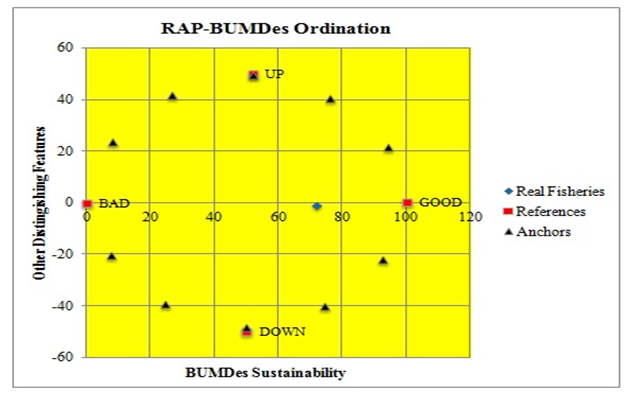 | Figure 1. The Economic Dimension Sustainability Index |
The results of the analysis of the modified rapfish into Rap-BUMDesa, known value of sustainability of BUMDesa Dasawarsa on the economic dimension that is equal to 71.80 and shows that the economic dimension has the status of sustainable enough. Results BUMDesa Rap-economic dimension has a pretty good analysis results as obtained stress value of 0.14 and the R2 value of 0.95, while the allowable stress value is not greater than 0.25 and the R2 value not greater than 1.b. Analysis of leverage attributes of the economic dimensionThe results of the analysis of the leverage of the attributes of the economic dimension can be seen in the figure below.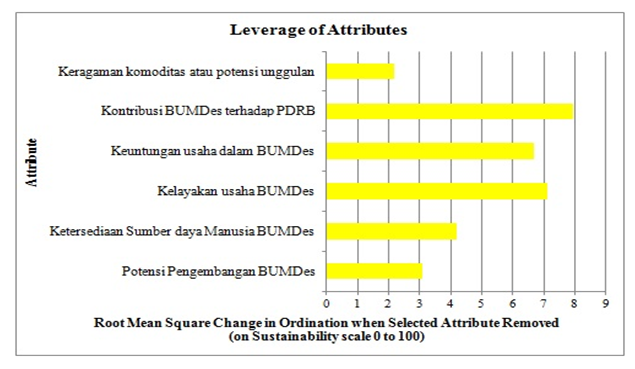 | Figure 2. Leverage Analysis Dimension attributes of Economy |
Value Root Mean Square (RMS) of each attribute in the economic dimension can be seen in Table 1:Table 1. Values RMS analysis of attributes of leverage on the economic dimension
 |
| |
|
Sensitive attribute is an attribute that can encourage and inhibit sustainability status development BUMDesa Dasawarsa the economic dimension. Sensitive attributes can be seen from the value Root mean square (RMS), if the RMS value of ≥ 2%, attribute falls within the category of sensitive (Lester, 2015).In this result that has the RMS value ≥ 2%, ie, all the economic dimension attributes. Attributes influence the sensitive and have a greater influence on the development Sustainability Dasawarsa BUMDesa namely Contributions BUMDesa to GDP, Feasibility BUMDesa business, and business advantage in BUMDesa, where all three of these attributes has a very high RMS value compared with other attributes.c. Monte Carlo analysis on the economic dimensionMonte Carlo analysis is used to determine and evaluate the impact of random errors of each attribute used to view the status of sustainability development BUMDesa Dasawarsa, The results of Monte Carlo analysis on the economic dimension of sustainability status Dasawarsa BUMDesa development can be seen in the figure below. | Figure 3. Monte Carlo Analysis Economic Dimension |
Monte carlo analysis of the economic dimension shows the results were quite good (did not have a significant error range) is indicated with accumulated dots (scatter plot) results repetition MDS ordination point position or close to each other as shown in the above. Ordination point position adjacent indicate that the results of repetition as much as 25 times are in the range of values from 65.66 to 72.14.
4.2. Dasawarsa BUMDesa Sustainability Status Analysis on Social Dimension
a. Rap-BUMDesa Ordination Analysis on the Social DimensionSocial dimension comprised of 6 attribute sustainability, among others: formal education level of employees, empowerment of rural communities in BUMDesa activities, role of the community in the activities BUMDesa, Public perception of BUMDesa, Frequensi conflict, level of employment. | Figure 4. Social Dimensions of Sustainability Index |
Social dimension of sustainability index on the Dasawarsa BUMDesa development can be seen in the above. Attributes on the social dimensions give consideration the effects on the sustainability of development BUMDesa Dasawarsa. Based on the analysis rapfish is modified into a Rap-BUMDesa, known value of sustainability of BUMDesa Dasawarsa on Social dimension that is equal to 65.29 and suggests that the social dimension has the status of sustainable enough. Rap-BUMDesa results of the social dimension have a pretty good analysis results as obtained stress value of 0.15 and the R2 value of 0.94, while the allowable stress value is not greater than 0.25 and the R2 value not greater than 1.b. Analysis of leverage attributes of the social dimensionThe results of the analysis of the leverage of the attributes of the social dimension can be seen in the figure below. | Figure 5. Leverage Analysis attributes of the Social Dimension |
Table 2. RMS value of the leverage analysis of attributes of the social dimension
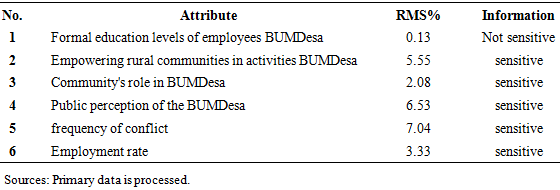 |
| |
|
Value Root Mean Square (RMS) of each attribute in the social dimension can be seen in the table above. Sensitive attributes are attributes that contribute to the sustainability status of the dimension to be assessed, where this attribute is able to encourage and inhibit sustainability status development BUMDesa Dasawarsa on the social dimension. In this result that has the RMS value ≥ 2%, ie, all the attributes of a social dimension. Attributes influence the sensitive and have a greater influence on the development Sustainability Frequency BUMDesa Dasawarsa that conflict, the public perception of the BUMDesa, and empowerment of rural communities in the activities BUMDesa, where all three of these attributes has a very high RMS value compared with other attributes.c. Monte Carlo analysis on the social dimensionThe results of Monte Carlo analysis on the social dimension of sustainability status Dasawarsa BUMDesa development can be seen in the figure below.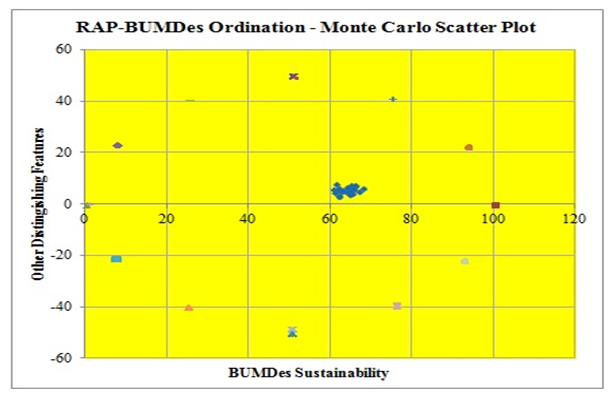 | Figure 6. Monte Carlo Analysis Social Dimension |
Monte carlo analysis of the social dimension show good results shown by mengumpulnya points (scatter plot) results repetition MDS ordination point position or close to each other as shown in the above. Ordination point position adjacent indicate that the results of repetition as much as 25 times are in the range of values from 60.94 to 67.67.
4.3. Sustainability Status Analysis of BUMDesa Dasawarsa on Legal and Institutional Dimensions
a. Rap-BUMDesa Ordination Analysis on Legal and Institutional DimensionsDimensions Legal and Institutional comprised of 6 attribute sustainability, among others: Cooperation across sectors in the development BUMDesa, law enforcement against violations of the rules BUMDesa, Devices Law and Religion, dominance of certain political groups, Sync central and regional policies, Adherence to run the existing rules on BUMDesa. | Figure 7. Sustainability Index Legal and Institutional Dimensions |
Attributes on legal and institutional dimensions give consideration the effects on the sustainability of development BUMDesa Dasawarsa. Based on the analysis of Rap-BUMDesa, known value of sustainability of BUMDesa Dasawarsa on legal and institutional dimension that is equal to 55.11 and shows that the legal and institutional dimensions have sustained enough status. Rap-BUMDesa Results legal and institutional dimensions have a pretty good analysis results as obtained stress value of 0.15 and the R2 value of 0.94, while the allowable stress value is not greater than 0.25 and the R2 value is not greater than 1.b. Dimensional Analysis of leverage attributes of the Law and InstitutionalLeverage analysis of attributes of the legal and institutional dimensions is used to determine the attributes - which attributes a significant effect on the sustainability status development BUMDesa Dasawarsa The Waru Waru Western District of Pamekasan. The results of the analysis of the leverage of the attributes of legal and institutional dimensions can be seen in the figure below. | Figure 8. Leverage Analysis attributes of Legal and Institutional Dimensions |
Value Root Mean Square (RMS) of each attribute in the legal and institutional dimensions can be seen in the table below.Table 3. Value of RMS on leverage analysis of attributes of the legal and institutional dimension
 |
| |
|
Sensitive attributes are attributes that contribute to the sustainability status of the dimension to be assessed, where this attribute is able to encourage and inhibit sustainability status development BUMDesa Dasawarsa the legal and institutional dimensions. In this result that has the RMS value ≥ 2%, ie, all the dimension attributes of institutional and legal dimensions. The influence of the attributes that are sensitive and have a greater influence on the sustainability development BUMDesa Dasawarsa namely Devices Law and Religion, dominance of certain political groups, and law enforcement against violations of the rules BUMDesa, where all three of these attributes has a value of RMS are very high compared with other attributes.c. Monte Carlo analysis on Legal and Institutional DimensionsThe results of Monte Carlo analysis on the legal and institutional dimensions of sustainability status Dasawarsa BUMDesa development can be seen in the figure below.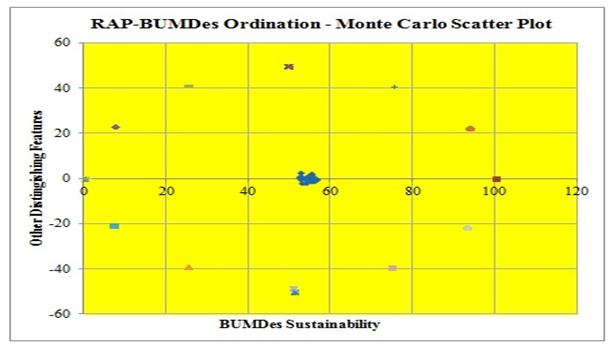 | Figure 9. Analysis of Monte Carlo Legal and Institutional Dimensions |
Monte carlo analysis of legal and institutional dimensions showed good results (did not have a significant error range) is indicated with the accumulated dots (scatter plot) results repetition MDS ordination point position or close to each other as shown in Figure above. Ordination point position adjacent indicate that the results of repetition as much as 25 times are in the range of values from 52.48 to 56.69.
4.4. Dasawarsa BUMDesa Sustainability Status Analysis on Infrastructure and Technology Dimensions
a. Rap-BUMDesa Ordination Analysis on Infrastructure and Technology DimensionsDimensions of Infrastructure consists of six attributes of sustainability, among others: Existence of supporting infrastructure in developing BUMDesa, Presence HR supervisor in the development BUMDesa, existence of a development program BUMDesa and empowerment of society, standardization of the quality of products produced BUMDesa, Availability Industrial Processing results, availability of Information Technology, | Figure 10. Dimensions Sustainability Index Infrastructure and Technology |
Based on the analysis of Rap-BUMDesa, known value of sustainability development dimension BUMDesa Dasawarsa on infrastructure and technology that is equal to 59.16 and showed that the infrastructure and technology dimensions have sustained enough status. Rap-dimensional Results BUMDesa infrastructure and technology have a pretty good analysis results as obtained stress value of 0.14 and the R2 value of 0.94, while the allowable stress value is not greater than 0.25 and the R2 value is not greater than 1.b. Dimensional Analysis of leverage attributes of the Infrastructure and TechnologyThe results of the analysis of the attributes of a dimension leverage the infrastructure and technology can be seen in the figure below: | Figure 11. Leverage Analysis Dimension attributes of Infrastructure and Technology |
Value Root Mean Square (RMS) of each attribute in the dimension of infrastructure and technology can be seen in the table below:Table 4. RMS value of the leverage analysis of attributes of the dimension of infrastructure and technology
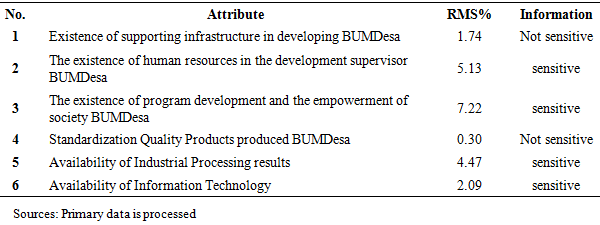 |
| |
|
In this result that has the RMS value ≥ 2%, ie, all the dimension attributes of infrastructure and technology dimensions. The influence of the attributes that are sensitive and have a greater influence on the sustainability development BUMDesa Dasawarsa ie presence of a development program BUMDesa and empowerment of society, existence of a development program BUMDesa and empowerment of society, and Availability of Industrial Processing of results, where all three of these attributes has a value of RMS are very high compared with the attribute another.c. Monte Carlo analysis on Dimensions of Infrastructure and TechnologyThe results of Monte Carlo analysis on the dimensions of infrastructure and technology in the development of sustainability status BUMDesa Dasawarsa can be seen in the figure below.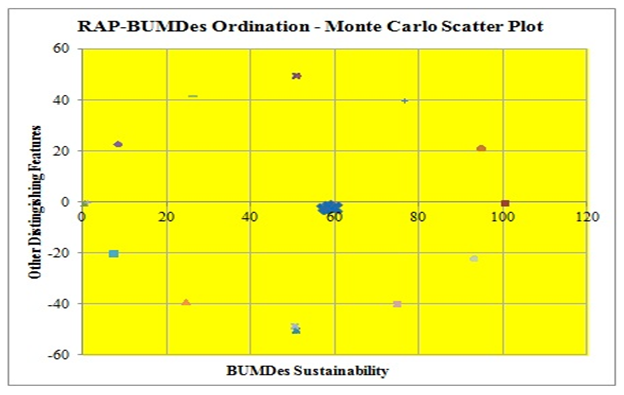 | Figure 12. Analysis of Monte Carlo Dimensions of Infrastructure and Technology |
Monte carlo dimensional analysis infrastructure and technology shows good results (did not have a significant error range) is indicated with dots mengumpulnya (scatter plot) results repetition MDS ordination point position or close to each other as shown in Figure above. Ordination point position adjacent indicate that the results of repetition as much as 25 times are in the range of values from 55.74 to 60.45.
4.5. BUMDesa Development Dasawarsa Sustainability Status in Multidimensional
Status sustainability sustainability status development BUMDesa Dasawarsa on the economic, social, legal and institutional infrastructure and technology when analyzed using the RAP-BUMDesa.npada each dimension showed the results as table.5:Table 5. Analysis of sustainability Status development of BUMDesa Dasawarsa on each dimension
 |
| |
|
The economic dimension has six attributes sensitive to show good results, or do not have a significant error range, it is shown by point analysis of the results repetition Multidimensional scaling (MDS), which collects between the value of 65.66 to 72.14 or point ordination remains at positions adjacent to each other. Status on the social dimensions of sustainability shows the results of Rap-BUMDesa Ordination of 65.29, which means that dimension is still in a fairly continuous ordinated scale. The social dimension has five attributes sensitive to show good results, or do not have a significant error range, it is shown by point analysis of the results repetition Multidimensional scaling (MDS), which collects between the value of 60.94 to 67.Status of sustainability in the legal and institutional dimensions show the results of Rap-BUMDesa Ordination of 55.11, which means that dimension is still in a fairly continuous ordinated scale. Legal and institutional dimension has three attributes sensitive to show good results, or do not have a significant error range, it is shown by point analysis of the results repetition Multidimensional scaling (MDS), which collects between the value of 52.48 to 56.69 or point ordination they are in a position adjacent to each other.Status dimensions of sustainability in infrastructure and technology shows the results of Rap-BUMDesa Ordination 59.16 which means that these dimensions is still in a fairly continuous ordinated scale. Infrastructure and technology dimensions have four attributes sensitive to show good results, or do not have a significant error range, it is shown by point analysis of the results repetition Multidimensional scaling (MDS), which collects between the value of 55.74 to 60.45 or point ordination they are in a position adjacent to each other.Once the status index value of sustainability in each - each dimension, namely, the economic, social, legal and institutional infrastructure and technology have been known to the sustainability status of the index value can be described on a kite diagram as follows: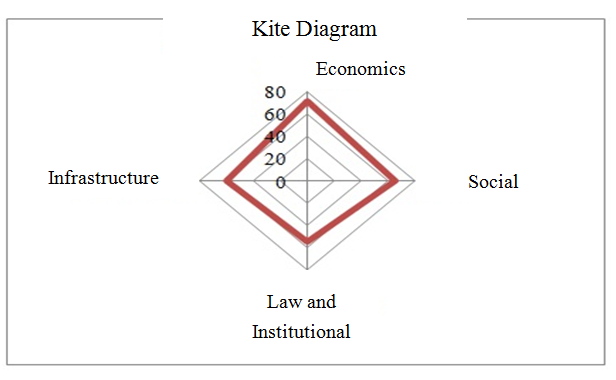 | Figure 13. Value Index sustainability status development Diagram BUMDesa Dasawarsa with Kite Diagram |
The results are multidimensional analysis above shows that the status of sustainability development of Dasawarsas BUMDesa currently on the status of sustainable enough with sustainability status index value of 62.84, the value of being proficiency level on a scale ordinated from 60.01 to 75.00. To maintain and enhance the sustainability of future status, need intervention (repair) of the attributes that affect the improvement of the status of sustainability. In addition it should be prioritized improvements attributes on the dimensions of sustainability which has a value of sustainability index lower, and the improvement of the attributes should not only be done on the attributes of a sensitive effect on the improvement of the status of sustainability, but also attributes that are not sensitive to the status of sustainability can be enhanced sustainability index values approaching 100 percent. Of course, with consideration of financial ability, time, and energy.Sustainability related to business development BUMDesa dimensional factors other than mentioned above are also factors governance of these institutions. (Herman Cahyo, D. 2017). Further results of the study, explained that the institutional governance is a key factor determining the success of the business of every kind BUMDesa. This is because any kind of business BUMDesa not stand alone but linked chain with other factors that influence the sustainability of the business. This linkage is like a chain and this chain broke when the work done by BUMDesa be affected. BUMDesa Sustainability is strongly influenced by the scale and outreach effort. BUMDesa run business internally (to serve the needs of local residents (such as staples, hand tractor rental) to reach and local scale, generally face a low risk so they can run a healthy and sustainable. (Herman Cahyo, D. 2017).The results of this study with research conducted by Syahril, Akhmad Faiz Mohammad Alif Ghufron and Herli the research results published in 2019, entitled "Factors Affecting Financial Performance Of Village Owned Enterprises: A Case Study In The District Of Rock Sumenep" the results showed that in the District BUMDesa have obstacles, such as capital, the lack of contained in BUMDesa has disadvantages, such as capital, less information about local government, as well as the lack of honor given to employee from local governments, as well as the lack of recognition given to employees in BUMDesa. Also, there are constraints that affecting financial performan instead, there is also a limiting factor affecting financial performance BUMDesa namely capital, responsibility, public education, beliefs, as well as the type BUMDesa namely capital, responsibility, public education, trust, and other types of business. The findings of this study all aspects that need to work together in building BUMDesa around the village of Sumenep.The results of the present study (2019) showed that the obstacles encountered in the development BUMDesa not only capital, the less information about local government, as well as the lack of honor given to employeefrom local governments, as well as the lack of recognition given to employees BUMDesa, but domination certain political groups as well be difficulties in implementing the Dasawarsa BUMDesa development. The dominance of a particular political group is sensitive highly viscous attribute the occurrence frequency of conflict. It can be seen on conditions that existed at dilapang fact, that the dominance of the political groups dominate in every policy or decision related to the progress and development of the Dasawarsa BUMDesa.
5. Conclusions and Suggestion
The results of this study memberikanm conclusion, among others (1). Dasawarsas BUMDesa sustainability status in Waru West, District Waru Pamekasan as multidimensional has an index value of sustainability status are included in the category of sustainable enough, meaning that the index value of all dimensions include: the economic, social, legal and institutional, infrastructure and technology has an influence on the sustainability BUMDesa Dasawarsa, (2). The most influential dimensions of the sustainability status BUMDesa Dasawarsa namely the economic dimension, when compared with the dimensions - other dimensions (social, legal and institutional, infrastructure and technology). The economic dimension has a value of the highest sustainability index and have a great chance to increase the sustainability status BUMDesa Dasawarsa,In addition, it also provides recommendations as follows (1). The government especially village government through village-owned enterprises (BUMDesa Dasawarsa), is expected to continue to explore potential that exists in the village and used and used for the welfare and improve the rural economy wise and sustainable, (2). The economic cooperation needs to be improved village-owned enterprises (BUMDesa) with associated people or stakeholder resulting in a mutually beneficial economic relationship, (3). Keeping the status for sustainability and do repairs to sensitive or attributes that affect the sustainability status BUMDesa Dasawarsa and improvement of the attributes that are not sensitive for their status to be improved sustainability sensitive attributes and (4). Improvements to the dimensions of sustainability attributes that have a value lower sustainability index to be prioritized, such as legal and institutional dimensions and infrastructure and technology. Meanwhile, economic and social dimensions of sustainability forward index value can be maintained or further improved.
References
| [1] | Adawiyah, R. (2018). Strategy Development of village-owned enterprises (BUMDesa) Based Aspects of Social Capital (Studies in BUMDesa Surya Sejahtera, Kedungturi Village, District Taman, Sidoarjo regency). Journal of Public Policy and Management, 6 (3), 1-15. |
| [2] | Anonymous. (2019, 01, 22). Profile Waru Southwestern Pamekasan. infodesaku.co.id, p. 1-3. |
| [3] | Bahareh Ansari, SM (2013). Sustainable Entrepreneurship in Rural Areas. Research Journal of Environmental and Earth Science, 26-31. |
| [4] | BPS, BP (2018). Pamekasan in Figures. Pamekasan: Statistics Pamekasan. |
| [5] | Diamonds Coristya Ramadana, HR (2013). The existence of village-owned enterprises (BUMDesa) For Rural Economic Empowerment (Studies in Rural Landungsari, District Dau, Malang). Journal of Public Administration (JAP), 1 (6), 1068-1076. |
| [6] | Dwiyanto, A. (1996). Reinventing Government: Principles of Mind and Its Relevance in Indonesia. Yogyakarta: Papers On Strategic Management Training for Director of Hospital by the Master. |
| [7] | Herman Cahyo, D. Institutional Development Strategy Against BUMDESA in Jember. Ekonomikawan Journal L Journal of Economics and Development Studies Vol. 17 No. 2, 2017. |
| [8] | I Gede Agus Ariutama, AH (2017). The Role Of Village-Owned Enterprises (BUMDesa) To Rural Development: A Comparative Institutional Analysis. Journal Of Regional Economic and Financial, 3 (3), 59-65. |
| [9] | Nurmalina, R. (2008). Analysis Sustainability Index and Status System Availability Rice in Several Indonesian Territory. Agro Economic Journal, 26 (1), 47-79. |
| [10] | Osborne, D. a. (1992). Reinventing Government: How the Entrepreneur Spirit is Transforming the Public Service, translation: Bureaucracy Mewirausahakan Transforming Entrepreneurial spirit to In Public Sector. Interpreting Abdul Rosyid and Ramelan. Jakarta: Pustaka Binaman Pressindo. |
| [11] | Prabowo, TH (2014). Developing BUMDesa (Village-owned Enterprise) for Sustainable Poverty Alleviation Model Village Community Study in Bleberan-Mount Kidul- Indonesia. World Applied Sciences Journal 30 (Innovation Challenges in Multidiciplinary Research & Practice), 19-26. |
| [12] | Princess Nugrahaningsih, FJ (2016). Optimization of the Village Fund Development of village-owned enterprises (Bum Des) Towards Independent Village. Journal of Accounting and Business, 16 (1), 37-45. |
| [13] | Ridlwan, Z. (2014). Urgency village-owned enterprises (BUMDesa) In Rural Economy Builders. Fiat justisia Journal of Legal Studies, 8 (3), 424-440. |
| [14] | Sebastiana Viphindrartin, MD (2018). Potentials, Constraints and Sharia-Based Financing Models on Cassava Agroindustry BUMDesa in Jember District. The International Journal of Social Sciences and Humanities Invention, 5 (02). |
| [15] | Srirejeki, K. (2017). Empowering the role of village owned enterprises (BUMDesa) for rural development: the case of Indonesia. Journal of Accounting, Management, and Economics, 20 (1), 5-10. |
| [16] | Wibowo Ab., USA (2015). tatus Sustainability Ecological Dimension In Minapolitan Region Sustainable Development Based Freshwater Aquaculture In Magelang. Fisheries Saintek Journal, 10 (2), 107-113. |
| [17] | Zulhakim, H. &. (2017). The existence of village-owned enterprises (BUMDesa) in Business and Economics Mengembangka Competitive Village Community in the Age of the ASEAN Economic Community. Journal of the National Secretariat of ASEAN, 1- 13. |
















 Abstract
Abstract Reference
Reference Full-Text PDF
Full-Text PDF Full-text HTML
Full-text HTML



